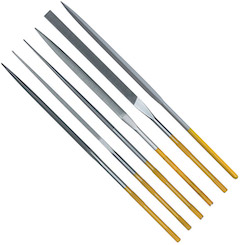HAND OPERATED EQUIPMENT
Individual tools are the tools that are directly in contact with the hand of the watchmaker and the object he wants to treat, and this without any demultiplier effect.
Individual tools were often made by the watchmaker himself during his first year of apprenticeship. Thus, he will also know how to sharpen them himself as regards screwdrivers or tweezers for example. Many watchmakers can tell if another watchmaker has graduated from the same school as him by looking at the tools he has on his bench. Sometimes they can even tell if they had the same teacher.

ABRASIVES
Abrasives are useful for shaping and decorating components, by hand or machine. They can be used to remove material (lapping, planing, diamond cutting, etc.) or to improve or decorate the surface (satin finishing, sandblasting, horological decorations, and polishing). Abrasives must always have a hardness greater than the material being treated.
BENZINE CUP
The benzine cup is a container regularly found on a watchmaker’s workbench. It contains rectified benzine, which is used to clean various components.
BUFF STICK
A buff stick is a slat-shaped piece of wood often covered with abrasive paper and sometimes leather.
BURNISHERS
Burnishers are tools used to cold-work material. There are mainly two different types of burnishers, one for rolling pivots and the other for polishing the angles of bridges or other parts.

BOW-LATHE
A bow-lathe is a tool that allows for the manual engaging of a component or a tool in rotative movements.

CHISELS
Chisels are cutting tools used mainly on a lathe. They can be hand-held, hand-operated chisels or larger chisels that are placed on a lathe carriage and moved by cranks.
DUST BLOWER
The dust blower is a tool used to compress air which is sent in a precise direction. This tool is often used for the final and individual cleaning of components.

FILES
Files are the watchmaker’s brushes. Very often after their purchase they are further refined and improved by the watchmaker and are used for example for bevelling.
PIERCING SAW
The piercing saw is used in watchmaking to do fine work such as cutting open skeleton movements.
SCREWDRIVERS
Essential tools for the watchmaker, screwdrivers come in different sizes and must always be perfectly adjusted so as not to mark the screws when used. Spare bits are often included with screwdrivers.

SHELLAC
Shellac is a natural lacquer used in watchmaking notably to hold pallets in place on the anchor.

TWEEZERS
Tweezers are used to handle small parts. However, the main reason for their use is not related to the size of the parts but essentially to prevent the natural moisture of the hands from coming into contact with the metal and oxidising or soiling the parts being handled.
VICE
The vice is an essential tool for watchmakers. It consists of two jaws that can clamp an object. It is often used as a component support.
VICE-BLOCK
Vice-blocks are supports, generally made of wood, that the watchmaker places in his vice to support a variety of work.
VICE-CLAMPS
Vice-clamps are inserts that are fitted on the jaws of a vice to protect the parts held in the vice.
BECOME A CONTENT CONTRIBUTOR
HOROPEDIA is a participative knowledge platform and we invite all those who wish to contribute to this adventure of sharing watchmaking knowledge to join us.
It can be additional explanations, images or other illustrations or terms not yet identified that deserve to be.

